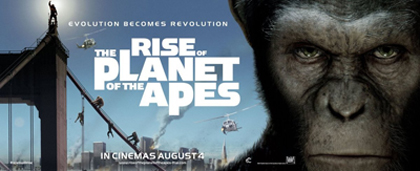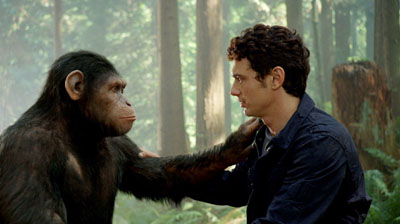‘Rise of the Planet of the Apes’
Martha Stallman
Rupert Wyatt, “Rise of the Planet of the Apes”
Twentieth Century Fox Film
2011, 105 minutes

Often, a movie that purports to be about a Very Special Animal might be more accurately described as a movie about how an encounter with that Very Special Animal impacts the life of the human protagonist who is the movie’s actual star—by helping him get the girl or by helping her learn that there’s more to life than work or by Teaching Us All How to Love…Again. “Free Willy” is not about a whale so much as it is about a young boy learning the value of friendship and the importance of fighting for one’s convictions. “Beethoven” is not about a dog, but about how that dog unexpectedly brings a family together. Peter Jackson’s remake of “King Kong” is less about a giant gorilla than it is about a beautiful girl with a soft spot for freakish creatures (apologies to Adrien Brody).
At first glance, “Rise of the Planet of the Apes” seems to fit this mold. The movie begins with an extended sequence focused on Dr. James Franco, a Dedicated Scientist who Cares Too Much, probably because he’s watching his father slowly succumb to Alzheimer’s. Through a rapid series of unfortunate events, Franco (his character has a name, but it’s so aggressively vanilla that I’ve forgotten it) comes into possession of a young chimpanzee, Caesar, whose embryonic exposure to the drug Franco was working on makes him smarter than the average chimp. Franco raises Caesar like the son he never had, allowing him to swing through San Francisco’s glossiest treetops with wild abandon and eat Cheerios at the big kid’s table, until Caesar gets popped by animal control and is forced, for the first time, to live with members of his own species. In ape lockdown (and not to be a jerk, but really? They have those? Your regular city animal control has an ape prison complete with ape exercise yard and ape solitary confinement and, presumably, ape sexual favors being traded for ape cigarettes and strawberry toilet wine?), Caesar learns that apes are assholes but people are bigger assholes, so he steals a bunch of Dr. Franco’s patented InstaSmart Brain Gas and doses his simian pals. Freshly ensmartened, the apes bust out, bust some other apes out, throw a few cars, blow some stuff up, and finally make their way to the beautiful CGI forest just on the other side of the Golden Gate bridge. Meanwhile, it turns out that brain gas is fatal to humans, so they start to die off, leaving the planet to the apes (SPOILER ALERT).
But “RotPotA” (as it will undoubtedly soon be known) dispenses with its human interlocutor well before the movie’s climax—in fact, from the moment Caesar is placed among them, it really does become all about the apes, with the human actors moved to the story’s margins. Familiar plot points of the Very Special Animal genre—Hero Finds Love with Luscious Veterinarian; Rambunctious Pets; and Old Folks are BFFs—are dutifully hit but given so little development that they seem like afterthoughts, requirements that are met with a minimum of effort. This is good because, as it turns out, a movie about animals can be hugely entertaining without all those bland people clogging it up. “Rise of the Planet of the Apes” is a surprisingly good movie of its kind, simply because it knows when to put boring humans and their boring problems away and focus on the car-throwing gorillas we all came to see. It’s not that Franco does a bad job—he’s perfectly serviceable, as are all the other human actors. It’s that, at any given time, there are a dozen movies in theaters making bold statements like Relationships Are Hard, or My Dad’s Old and Crazy, or You Have to Know When to Let Go, Man; but there are criminally few about super-intelligent ape riots. Why, then, would a person buy a ticket to a Very Special Animal movie when they really wanted to watch a movie about people and their feelings?
Still, it’s not difficult to imagine why moviemakers tend to focus on human actors even in movies that are supposed to be about animals. A human interlocutor offers the audience an easy point of identification and sympathy that an animal protagonist may not. Very few people hate animals; very few actively wish them harm; but even most animal lovers, if pressed, would admit to valuing an animal’s life less than a person’s. As sweetly big-eyed as that cow is, if it’s a choice between yanking her or a toddler out of the way of a speeding locomotive, most people will choose to save the toddler (and hopefully convince it not to play on train tracks anymore). As much as we love our dogs, seeing them lick their crotches fifty times a day does little to convince us of the rich complexity of their thoughts.
So, what does it mean when a Very Special Animal movie pushes its human touchstone to the side? It means the audience is being asked to identify not with the animal’s human buddy but with the animal itself. Moviemakers might facilitate this leap by making the animal as human as possible or making the humans as monstrous as possible, but it’s still a leap—the smartest chimp in the world is still a chimp, after all, and you wouldn’t want him doing your taxes or delivering your baby. Putting yourself in his place requires you not just to imagine yourself as a different creature, but as a being you most likely think of—however reluctantly—as a lesser creature. That “Rise of the Planet of the Apes” manages to pull off this sort of identification so successfully is impressive (to me, at least—as a lifelong fan of Ray Harryhausen and Jim Henson, my animosity towards modern, computer-generated special effects borders on the pathological) and the techniques the movie employs to accomplish this identification are fascinating.

Since many real movie critics have spoken eloquently about the motion-capture technology used to render Caesar so wonderfully expressive or about Andy Serkis’s uncanny ability to breathe life into digital characters, I’d like to take a moment to comment on something they haven’t: the movie’s use of place.
As I mentioned, the movie is set in San Francisco, a fact that says little in itself—plenty of movies are set in San Francisco, if for no other reason than to torture the Golden Gate bridge with yet another dumb computer effect (sorry, sorry). But San Francisco as imagined in “RotPotA” is not just setting, but metaphor. The city itself is crowded with concrete and steel, with big, scary laboratories and nasty neighbors—but just across the bridge are woods of such primordial lushness that they seem of another world. The city is a place of necessary containment, of zoos and ape prisons; the woods across the bridge let you take your chimp off-leash. The city is where Dr. Franco makes his medical breakthroughs; the woods are where Caesar enjoys their benefit. Tons of movies pit The Dirty City and some Romanticized Nature against each other, but not many combine them into one coherent magical place the way this movie does. The San Francisco of “RotPotA” is the best of both worlds, unspoiled wilderness with the convenience of indoor plumbing.
How fitting, then, that this should be the backdrop for a movie about a chimp with the mind of a man, an animal as dependent upon the technology of the city as he is the freedom of the wilderness, an animal we are meant to regard, by movie’s end, as no less than human. In this mystical San Francisco, we find the perfect illustration of our longing to enjoy all the advantages of modern life while maintaining a connection to and mastery of wild places—in Caesar, we find the perfect character to satisfy that longing. In pushing actual people to the margins and giving us a protagonist at once recognizable and alien, “Rise of the Planet of the Apes” allows us to explore that uniquely human urge to both be and not be the Very Special Animals that we are.

Martha Stallman lives and writes in Austin, Texas.

1 comment on “Review: Stallman”